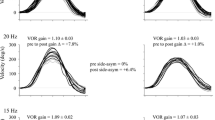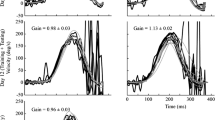Abstract
While sustained retinal slip is assumed to be the basic conditioning stimulus in adaptive modifications of the vestibulo-ocular reflex (VOR) gain, several observations suggest that eye motion-related signals might also be involved. We oscillated pigmented rats over periods of 20 min around the vertical axis, at 0.3 Hz and 20°/s peak velocity, in different retinal slip and/or eye motion conditions in order to modify their VOR gain. The positions of both eyes were recorded by means of a phase-detection coil system with the head restrained. The main findings came from the comparison of two basic conditions — including their respective controls — in which one or both eyes were reversibly immobilised by threads sutured to the eyes. In the first condition the animals were rotated in the light with one eye immobilised and the other eye free to move but covered. Rotation in the light in this open-loop condition immediately elicited high-gain compensatory eye movements of the non-impeded, covered eye. At the end of this training procedure, the VOR gain increased by 42.3%. In the second condition, both eyes were immobilised and one eye was covered. The result was an increase in the VOR gain of 26.3%. These two conditions were similar as to the visuo-vestibular drive during the exposure, but different as to the resulting — and allowed — eye motion, showing that the condition where the larger eye movements occurred yielded the larger VOR gain change. Our data support the idea proposed by Collewijn and Grootendorst (1979, p. 779) and Collewijn (1981, p. 146) that “[retinal] slip and eye movements seem to be relevant signals for the adaptation of the rabbit's visuo-vestibular oculomotor reflexes”. Our data also suggest that sensory information related to eye movements, more likely than efference copy, is the coding signal for eye movement which combines with the retinal slip signal to generate adaptive changes of the VOR.
Similar content being viewed by others
References
Ashton JA, Donaldson IML, Milleret C (1986) Afferent signals from the extraocular muscles reach the vestibular nuclei and cerebellum in the trout. Proc Physiol Soc 376:21–22
Ashton JA, Boddy A, Dean SR, Milleret C, Donaldson IML (1988) Afferent signals from cat extraocular muscles in the medial vestibular nucleus, the nucleus prepositus hypoglossi and adjacent brainstem structures. Neuroscience 26:131–145
Ashton JA, Milleret C, Donaldson IML (1989) Effects of afferent signals from the extraocular muscles upon units in the cerebellum, vestibular nuclear complex and oculomotor nucleus of the trout. Neuroscience 31:529–541
Baker R, Precht W, Llinás R (1972) Mossy and climbing fibre projections of extraocular muscle afferents to the cerebellum. Brain Res 38:440–445
Baloh RW, Lyerly K, Yee RD, Honrubia V (1984) Voluntary control of the human vestibulo-ocular reflex. Acta Otolaryngol 97:1–6
Barr CC, Schultheis LW, Robinson DA (1976) Voluntary, non-visual control of the human vestibulo-ocular reflex. Acta Otolaryngol 81:365–375
Batini C, Buisseret P, Buisseret-Delmas C (1975) Trigeminal pathway of the extrinsic eye muscle afferents in cat. Brain Res 85:74–78
Blanks RHI, Precht W (1983) Responses of units in the rat cerebellar flocculus during optokinetic and vestibular stimulation. Exp Brain Res 53:1–15
Bridgeman B, Stark L (1991) Ocular proprioception and efference copy in registering visual direction. Vision Res 31:1903–1913
Buisseret P, Maffei L (1977) Extraocular proprioceptive projections to the visual cortex. Exp Brain Res 28:421–425
Campos EC, Bolzani R, Schiavi C, Fanti M R, Cavallini GM (1989) Further evidence for the role of proprioception in space perception. Doc Ophthalmol 72:155–160
Collewijn H (1981) The oculomotor system of the rabbit and its plasticity. Study of brain function, vol 5. Springer, Berlin Heidelberg New York
Collewijn H, Grootendorst AF (1979) Adaptation of optokinetic and vestibulo-ocular reflexes to modified visual input in the rabbit. In: Granit R, Pompeiano O (eds) Reflex control of posture and movement. Elsevier, Amsterdam, pp 771–781
de'Sperati C, Tempia F, Marchetti-Gauthier E, Strata P, Gauthier GM (1992) Influence of eye motion on vestibulo-ocular reflex (VOR) adaptation in rats. Pflugers Arch 421:R17
de'Sperati C, Tempia F, Harvey R, Strata P (1994) Vergence compensation during binocularly — and monocularly — evoked horizontal optokinetic nystagmus in the pigmented rat. Vision Res 34:3335–3345
Donaldson IML, Knox PC (1988) Units in pigeon brainstem whose vestibular responses are modulated by passive eyemovement. J Physiol (Lond) 398:35P
Donaldson IML, Knox PC (1991) Afferent signals from pigeon extraocular muscles modify the vestibular responses of units in the abducens nucleus. Proc R Soc Lond [Biol] 244:233–239
Donaldson IML, Knox PC (1993) Evidence for corrective effects of afferent signals from the extraocular muscles on single units in the pigeon vestibulo-ocular system. Exp Brain Res 95:240–250
Fuchs AF, Kornhuber HH (1969) Extra-ocular muscle afferents to the cerebellum of the cat. J Physiol (Lond) 200:713–722
Gauthier GM, Robinson DA (1975) Adaptation of the human vestibuloocular reflex to magnifying lenses. Brain Res 92:331–335
Gauthier GM, Nommay D, Vercher JL (1990a) The role of ocular muscle proprioception in visual localization of targets. Science 249:58–61
Gauthier GM, Nommay D, Vercher JL (1990b) Ocular muscle proprioception and visual localization of targets in man. Brain 113:1857–1871
Hoel PG (1966) Introduction to mathematical statistics. Wiley, New York
Kimura M, Maekawa K (1981) Activity of flocculus Purkinje cells during passive eye movements. J Neurophysiol 46:1004–1017
Knox PC, Donaldson IML (1993) Afferent signals from the extraocular muscles of the pigeon modify the vestibulo-ocular reflex. Proc R Soc Lond [Biol] 253:77–82
Lisberger SG, Fuchs AF (1978a) Role of primate flocculus during rapid behavioural modification of vestibuloocular reflex. I. Purkinje cell activity during visually guided horizontal smooth pursuit eye movements and passive head rotation. J Neurophysiol 41:733–761
Lisberger SG, Fuchs AF (1978b) Role of primate flocculus during rapid behavioural modification of vestibuloocular reflex. II. Mossy fibre firing patterns during horizontal head rotation and eye movement. J Neurophysiol 41:764–777
Ludvigh E (1952) Possible role of proprioception in the extraocular muscles. Arch Ophthalmol 48:436–441
Maekawa K, Kimura M (1980) Mossy fibre projections to the cerebellar flocculus from the extraocular muscle afferents. Brain Res 191:313–325
Mandl G, Melvill-Jones G, Cynader M (1981) Adaptability of the vestibulo-ocular reflex to vision reversal in strobe reared cats. Brain Res 209:35–45
Markert G, Büttner U, Straube A, Boyle R (1988) Neuronal activity in the flocculus of the alert monkey during sinusoidal optokinetic stimulation. Exp Brain Res 70:134–144
Melvill-Jones G (1985) Adaptive modulation of VOR parameters by vision. Rev Oculomot Res 1:21–50
Melvill-Jones G, Mandl G (1979) Effects of strobe light on adaptation of vestibulo-ocular reflex (VOR) to vision reversal. Brain Res 164:300–303
Melvill-Jones G, Berthoz A, Segal B (1984) Adaptive modification to the vestibulo-ocular reflex by mental effort in darkness. Exp Brain Res 56:149–153
Milleret C (1987) Projections centrales des afférences proprioceptives issues des muscles extraoculaires chez les vertébrés. Quelques rôles fonctionnels possibles dans le contrôle de l'oculomotricité, la perception visuelle et l'orientation corporelle. Agressologie 28:917–924
Miles FA, Fuller JH (1975) Visual tracking and the primate flocculus. Science 189:1000–1002
Miles FA, Lisberger SG (1981) Plasticity in the vestibulo-ocular reflex: a new hypothesis. Annu Rev Neurosci 4:273–299
Noda H, Suzuki DA (1979) Processing of eye movement signals in the flocculus of the monkey. J Physiol (Lond) 294:349–364
O'Keefe LP, Berkley MA (1991) Binocular immobilization induced by paralysis of the extraocular muscle of one eye: evidence for an interocular proprioceptive mechanism J Neurophysiol 66:2022–2033
Post RB, Lott LA (1992) The relationship between vestibulo-ocular reflex plasticity and changes in apparent concomitant motion. Vision Res 32:89–96
Schwarz DWF, Tomlinson RD (1977) Neuronal responses to eye muscle stretch in cerebellar lobule VI of the cat. Exp Brain Res 27:101–111
Steinbach MJ (1986) Inflow as long-term calibrator of eye position in humans. Acta Psychol 63:297–306
Steinbach MJ, Smith DR (1981) Spatial localization after strabismus surgery: evidence for inflow. Science 213:1407–1408
Tempia F, Dieringer N, Strata P (1991) Adaptation and habituation of the vestibulo-ocular reflex in intact and inferior olive-lesioned rats. Exp Brain Res 86:568–578
Author information
Authors and Affiliations
Rights and permissions
About this article
Cite this article
Gauthier, G.M., de'Sperati, C., Tempia, F. et al. Inluence of eye motion on adaptive modifications of the vestibulo-ocular reflex in the rat. Exp Brain Res 103, 393–401 (1995). https://doi.org/10.1007/BF00241498
Received:
Accepted:
Issue Date:
DOI: https://doi.org/10.1007/BF00241498




